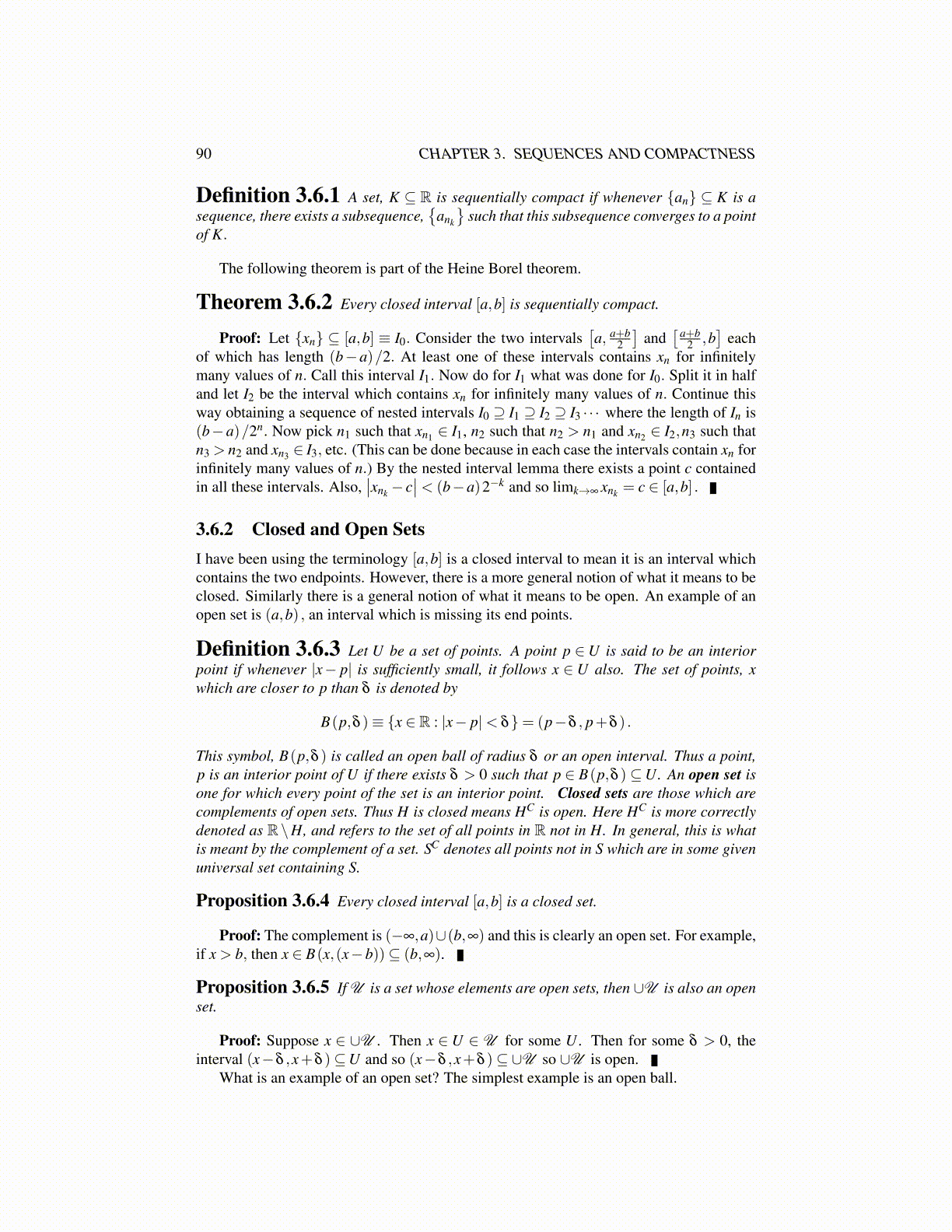
90 CHAPTER 3. SEQUENCES AND COMPACTNESS
Definition 3.6.1 A set, K ⊆ R is sequentially compact if whenever {an} ⊆ K is asequence, there exists a subsequence,
{ank
}such that this subsequence converges to a point
of K.
The following theorem is part of the Heine Borel theorem.
Theorem 3.6.2 Every closed interval [a,b] is sequentially compact.
Proof: Let {xn} ⊆ [a,b] ≡ I0. Consider the two intervals[a, a+b
2
]and
[ a+b2 ,b
]each
of which has length (b−a)/2. At least one of these intervals contains xn for infinitelymany values of n. Call this interval I1. Now do for I1 what was done for I0. Split it in halfand let I2 be the interval which contains xn for infinitely many values of n. Continue thisway obtaining a sequence of nested intervals I0 ⊇ I1 ⊇ I2 ⊇ I3 · · · where the length of In is(b−a)/2n. Now pick n1 such that xn1 ∈ I1, n2 such that n2 > n1 and xn2 ∈ I2,n3 such thatn3 > n2 and xn3 ∈ I3, etc. (This can be done because in each case the intervals contain xn forinfinitely many values of n.) By the nested interval lemma there exists a point c containedin all these intervals. Also,
∣∣xnk − c∣∣< (b−a)2−k and so limk→∞ xnk = c ∈ [a,b] .
3.6.2 Closed and Open SetsI have been using the terminology [a,b] is a closed interval to mean it is an interval whichcontains the two endpoints. However, there is a more general notion of what it means to beclosed. Similarly there is a general notion of what it means to be open. An example of anopen set is (a,b) , an interval which is missing its end points.
Definition 3.6.3 Let U be a set of points. A point p ∈ U is said to be an interiorpoint if whenever |x− p| is sufficiently small, it follows x ∈ U also. The set of points, xwhich are closer to p than δ is denoted by
B(p,δ )≡ {x ∈ R : |x− p|< δ}= (p−δ , p+δ ) .
This symbol, B(p,δ ) is called an open ball of radius δ or an open interval. Thus a point,p is an interior point of U if there exists δ > 0 such that p ∈ B(p,δ ) ⊆U. An open set isone for which every point of the set is an interior point. Closed sets are those which arecomplements of open sets. Thus H is closed means HC is open. Here HC is more correctlydenoted as R\H, and refers to the set of all points in R not in H. In general, this is whatis meant by the complement of a set. SC denotes all points not in S which are in some givenuniversal set containing S.
Proposition 3.6.4 Every closed interval [a,b] is a closed set.
Proof: The complement is (−∞,a)∪(b,∞) and this is clearly an open set. For example,if x > b, then x ∈ B(x,(x−b))⊆ (b,∞).
Proposition 3.6.5 If U is a set whose elements are open sets, then ∪U is also an openset.
Proof: Suppose x ∈ ∪U . Then x ∈ U ∈ U for some U . Then for some δ > 0, theinterval (x−δ ,x+δ )⊆U and so (x−δ ,x+δ )⊆ ∪U so ∪U is open.
What is an example of an open set? The simplest example is an open ball.